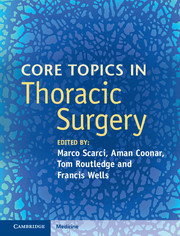Book contents
- Frontmatter
- Contents
- List of contributors
- Section I Diagnostic work-up of the thoracic surgery patient
- Section II Upper airway
- Section III Benign conditions of the lung
- 7 Congenital and developmental lung malformations
- 8 Lung volume reduction surgery for the treatment of advanced emphysema
- 9 Surgical aspects of infectious conditions of the lung
- 10 Treatment of haemoptysis
- Section IV Malignant conditions of the lung
- Section V Diseases of the pleura
- Section VI Diseases of the chest wall and diaphragm
- Section VII Disorders of the esophagus
- Section VIII Other topics
- Index
- References
7 - Congenital and developmental lung malformations
from Section III - Benign conditions of the lung
Published online by Cambridge University Press: 05 September 2016
- Frontmatter
- Contents
- List of contributors
- Section I Diagnostic work-up of the thoracic surgery patient
- Section II Upper airway
- Section III Benign conditions of the lung
- 7 Congenital and developmental lung malformations
- 8 Lung volume reduction surgery for the treatment of advanced emphysema
- 9 Surgical aspects of infectious conditions of the lung
- 10 Treatment of haemoptysis
- Section IV Malignant conditions of the lung
- Section V Diseases of the pleura
- Section VI Diseases of the chest wall and diaphragm
- Section VII Disorders of the esophagus
- Section VIII Other topics
- Index
- References
Summary
Landmarks
• There are three main congenital lung malformations: cystic forms also named congenital pulmonary airway malformation (CPAM), broncho-pulmonary sequestrations (BPS) and congenital lobar emphysema also named congenital alveolar overdistension. Among them, cystic lung malformations are the most frequent.
• Cystic lung malformations are focal and occur sporadically, suggesting they result from a defect in normal lung development rather from a genetic abnormality.
• The description of hybrid malformation, associating CPAM and sequestration features and the observation of microcystic elements in about half of extralobar sequestrations reflect the complex status of pulmonary malformations.
• Prenatal mediastinal shift is observed in 50% of CPAM and polyhydramnios in 20% of cases; both of these signs do not have to be interpreted as complications and do not lead to impaired lung development or fetal distress. On the opposite, hydrops is present in about 10% of cases and is associated to fetal or neonatal death in more than 95%.
• The ‘disappearance’ of congenital malformations of the lung on last prenatal ultrasound was classically described and interpreted as a complete regression of the malformation, but such evolution is exceptional and only documented for sequestrations. Post-natal thoracic imaging (MRI or CT scan) is required to check the persistence of congenital lung malformations regardless of the prenatal evolution.
• Cystic lesions are congenital lung malformations for which complications are most often reported. Respiratory impairment and lung infection are the two main symptoms but, although exceptional, they are associated to malignant degeneration. If non-operated, asymptomatic cystic lesions have to be followedup into adulthood.
• Over 90% of bronchopulmonary sequestrations are found in the thorax, and less than 10% are located in the abdomen. As respiratory symptoms are rare and no malignancy reported, expectance can then be proposed, provided that there is no cystic component.
• Progressive respiratory signs, secondary to lobar overinflation, are the most common symptoms in congenital lobar emphysema. Signs may have a favourable evolution with clinical and ventilatory parameter improvements. In case of respiratory distress, surgical excision of the malformation is necessary.
Important publications in the speciality
• Morrisey E, Hogan B. Preparing for the first breath: genetic and cellular mechanisms in lung development. Dev Cell 2010; 18:8–23.
- Type
- Chapter
- Information
- Core Topics in Thoracic Surgery , pp. 57 - 68Publisher: Cambridge University PressPrint publication year: 2016



